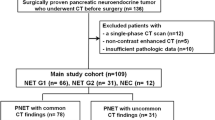Abstract
Objective
To compare the multidetector CT (MDCT) patterns of local invasion and clinical findings at presentation in patients with adenocarcinoma of the uncinate process of the pancreas to patients with adenocarcinomas in the non-uncinate head of the pancreas.
Methods
We evaluated the two cohorts for common duct and pancreatic duct dilatation, mesenteric vascular encasement, root of mesentery invasion, perineural invasion and duodenal invasion. In addition, we compared the clinical findings at presentation in both groups.
Results
Common duct (P < 0.001) and pancreatic duct dilatation (P = 0.001) were significantly less common in uncinate process adenocarcinomas than in the non-uncinate head of the pancreas. Clinical findings of jaundice (P = 0.01) and pruritis (P = 0.004) were significantly more common in patients with lesions in the non-uncinate head of the pancreas. Superior mesenteric artery encasement (P = 0.02) and perineural invasion (P = 0.001) were significantly more common with uncinate process adenocarcinomas.
Conclusion
Owing to its unique anatomic location, adenocarcinomas within the uncinate process of the pancreas have significantly different patterns of both local invasion and clinical presentation compared to patients with carcinomas in the non-uncinate head of the pancreas.
Key Points
• SMA encasement and perineural invasion were more common with uncinate process adenocarcinomas.
• Common bile duct and pancreatic duct dilatation were less common in uncinate process adenocarcinomas
• Jaundice and pruritis were more common with lesions elsewhere in the pancreatic head








Similar content being viewed by others
References
Cameron JL, Riall TS, Coleman J et al (2006) One thousand consecutive pancreaticoduodenectomies. Ann Surg 244:10–15
Birk D, Schoenberg MH, Gansauge F et al (1998) Carcinoma of the head of the pancreas arising from the uncinate process. Br J Surg 85:498–501
Suzuki T, Kuratsuka H, Uchida K et al (1972) Carcinoma of the pancreas arising in the region of the uncinate process. Cancer 30:796–800
Li S, Pei YQ, Du FT et al (2002) Surgical treatment for uncinate process carcinoma of the pancreas. Hepatobiliary Pancreat Dis Int 1:592–594
Ye C, Xi PC, Hu XG et al (2003) Clinical analysis of uncinate process carcinoma of the pancreas. Hepatobiliary Pancreat Dis Int 2:605–608
O’Sullivan AW, Heaton N, Rela M (2009) Cancer of the uncinate process of the pancreas: surgical anatomy and clinicopathological features. Hepatobiliary Pancreat Dis Int 8:569–572
Kang MJ, Jang J-Y, Lee SE et al (2010) Comparison of the long-term outcomes of uncinate process cancer and non-uncinate process pancreas head cancer: poor prognosis accompanied by early locoregional recurrence. Langenbecks Arch Surg 395:697–706
Lu DSK, Reber HA, Krasny RM et al (1997) Local staging of pancreatic cancer: criteria for unresectability of major vessels as revealed by pancreatic-phase, thin-section helical CT. AJR Am J Roentgenol 168:1439–1443
Hough TJ, Raptopoulos V, Siewert B, Matthews JB (1999) Teardrop superior mesenteric vein: CT sign for unresectable carcinoma of the pancreas. AJR Am J Roentgenol 173:1509–1512
Deshmukh SD, Willmann JK, Jeffrey RB (2010) Pathways of extrapancreatic perineural invasion by pancreatic adenocarcinoma: evaluation with 3D volume-rendered MDCT imaging. AJR Am J Roentgenol 194:668–674
Tian H, Mori H, Matsumoto S et al (2007) Extrapancreatic neural plexus invasion by carcinomas of the pancreatic head region: evaluation using thin-section helical CT. Radiat Med 25:141–147
Hirai I, Kimura W, Ozawa K et al (2002) Perineural invasion in pancreatic cancer. Pancreas 24:15–25
Nagakawa T, Kayahara M, Ohta T et al (1991) Patterns of neural and plexus invasion of human pancreatic cancer and experimental cancer. Int J Pancreatol 10:113–119
Kayahara M, Nagakawa T, Konishi I et al (1991) Clinicopathological study of pancreatic carcinoma with particular reference to the invasion of the extrapancreatic neural plexus. Int J Pancreatol 10:105–111
Nakao A, Harada A, Nonami T et al (1996) Clinical significance of carcinoma invasion of the extrapancreatic nerve plexus in pancreatic cancer. Pancreas 12:357–361
Makino I, Kitagawa H, Ohta T et al (2008) Nerve plexus invasion in pancreatic cancer: spread patterns on histopathologic and embryological analyses. Pancreas 37:358–365
Yi SQ, Miwa K, Ohta T et al (2003) Innervation of the pancreas from the perspective of perineural invasion of pancreatic cancer. Pancreas 27:225–229
Atri M, Nazarnia S, Mehlo A et al (1994) Hypoechogenic embryologic ventral aspect of the head and uncinate process of the pancreas: in vitro correlation of US with histopathologic findings. Radiology 190:441–444
Mochizuki K, Gabata T, Kozaka K et al (2010) MDCT findings of extrapancreatic nerve plexus invasion by pancreas head carcinoma: correlation with en bloc specimens and diagnostic accuracy. Eur Radiol 20:1757–1767
Author information
Authors and Affiliations
Corresponding author
Rights and permissions
About this article
Cite this article
Padilla-Thornton, A.E., Willmann, J.K. & Jeffrey, R.B. Adenocarcinoma of the uncinate process of the pancreas: MDCT patterns of local invasion and clinical features at presentation. Eur Radiol 22, 1067–1074 (2012). https://doi.org/10.1007/s00330-011-2339-4
Received:
Revised:
Accepted:
Published:
Issue Date:
DOI: https://doi.org/10.1007/s00330-011-2339-4




